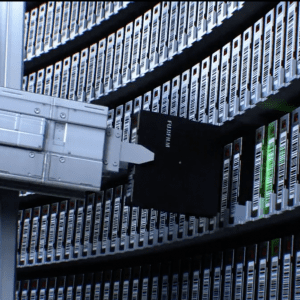In today’s HPC marketplace, data analysis is essential for gaining critical insights and answers to complex problems. What many researchers don’t realize, however, is that collecting data is just the first step in the process. On their own, millions of pieces of data have no meaning. Data analysts have the important task of taking vast amounts of raw data and turning it into information that other professionals can use to solve problems and make better decisions.
To ensure data analysts and other personnel have access to the data they need, organizations of all sizes must leverage flexible data storage solutions. The best solutions grow with the business, eliminating the need to find a new solution every time the organization wants to tackle a new problem. Effective data storage is especially important for research entities that rely on high-performance computing to process large volumes of data on a regular basis. Fortunately, today’s modern and highly advanced tape systems offer a scalable solution for streamlining data workflows.

High-performance computing is driven by many of the world’s greatest challenges. Through HPC, revolutionary scientific discoveries are made, game-changing innovations are powered, and quality of life is transformed and improved for billions around the world. For high-performance computing, the ability to process massive amounts of data and store that data for future reference has become more essential than ever.
Therefore, it’s critical for HPCs to have a data storage solution that can easily scale to handle exponential data growth without exponential budget growth. Effective data storage is especially important for researchers who need to keep track of vast amounts of data for long periods of time including study participants, compliance with legal and ethical requirements governing the use of research subjects, and store millions of pieces of data related to individual experiments.
Traditional file storage has limitations in scale and management, providing complexity and challenges for future data growth. In contrast, tape storage complements HPC workflows in scale and has the capability to manage large amounts of data sets without straining your budget. At the university level, for example, the limitations of long-term data storage make it more difficult for researchers to access data, share it with others and use it to make breakthrough discoveries.
Even if a single department is in charge of a research project, researchers from multiple departments may need to access the data, increasing the demand for easily accessible and scalable data storage solutions. For example, genetics researchers may be responsible for collecting data, but employees from the institutional review board may need access to that data to ensure the project complies with organizational guidelines. Many storage solutions don’t provide the level of flexibility needed to store, retrieve and analyze data at scale and then cost effectively store it for long periods of time until it’s needed again for re-analysis.

HPC organization researchers are bound by a variety of state and federal regulations, along with institution-specific policies regarding data retention. The data retention period typically lasts for at least five years, but it may be even longer for researchers handling certain types of data that would be too costly or impractical to reproduce. For example, the Health Insurance Portability and Accountability Act (HIPAA) requires researchers to retain protected health information for six years after each participant signs an authorization and general health records are often kept for the life of patients.
In many cases, it’s impossible to reproduce lost data; even if it can be reproduced, the reproduction process may be prohibitively expensive. When working with priceless, irreplaceable data, today’s highly advanced and automated tape storage systems give you extra peace of mind thanks to its high reliability and long archival life.

Another challenge of data collection in research is the limited amount of available funds. Many worthwhile projects never move forward due to a lack of funding; even when a project is approved, researchers simply don’t have unlimited funds available to test their hypotheses and comply with data-retention requirements. Although cloud storage seems convenient, you need to consider the total cost of ownership. Bandwidth limitations on low-cost plans slow down your connection, making it more difficult to work with research data. If you want better performance, you must pay for upgrades, leaving you with less funding available for critical research activities. Additionally, the need for multi-tenant access can lead to higher egress fees when retrieving data from cloud environments.

As noted previously, researchers aren’t the only people who need to access their data. Multiple groups, users and departments must use secure logins and secure keys to access buckets of data, increasing complexity. Fujifilm supports object storage solutions that enable full chain of custody and access control, managing your sensitive data on-premises.
In some cases, hundreds of researchers need access to the same data, requiring them to use the same databases. Although cloud storage providers allow users to enter data for free, they charge egress fees for data retrieval. The more people who need access to your data, the higher your egress fees, making cloud storage a challenging solution for typical research departments.
Many organizations have their own HPC centers, but they don’t have the same needs as businesses that rely on HPC to develop new products and services or find better ways to serve paying customers. As a result, researchers face some unique challenges when choosing data archiving solutions. Two of the most common challenges for researchers are the quick consumption of primary storage and the complexity of data storage and retrieval.

One of the most common challenges for researchers are the quick consumption of primary storage. Primary storage is expensive, so researchers need solutions to help them reduce the cost of data storage. Historic transcripts and decades’ worth of research are valuable, but it’s not cost-effective to use up primary storage on cold data. On premises archiving with modern tape systems makes it possible to store inactive data securely without increasing your data egress fees from multi-tenant access.

The right storage solution depends on how much data you have and how often you need to access it. If latency is your main concern, solid-state disks are often the best option. Hard disk drives are also an appropriate data storage solution if performance and speed are your top priorities.
If you need a scalable solution for infrequently accessed data, tape storage is the most economical. Tape storage uses magnetic tape drives to read and write data. When stored properly, tape lasts for decades, making it easier to comply with data-retention rules and regulations. It’s also possible to move tapes elsewhere in anticipation of natural disasters, preventing data loss and ensuring that you can continue complying with retention requirements.

With Fujifilm Tape , increasing capacity is as simple as using an automated tape library for cold data storage. Today’s highly advanced tape is ideal for universities, government agencies, and other HPC organizations that need scalable research data storage solutions, as it uses the latest advanced technology to enhance security and reduce costs. In fact, tape systems reduce storage costs by up to 80%, making it easier than ever to keep up with data demands, enhance collaboration and comply with data-retention requirements.